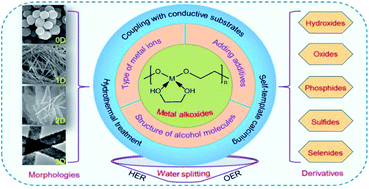Recent advances on metal alkoxide-based electrocatalysts for water splitting†
Abstract
Electrocatalytic water splitting to produce clean and sustainable hydrogen energy is regarded as a promising strategy to address the growing energy and environmental problems. Thus, the search for low-cost and efficient electrocatalysts plays a vital role in water electrolysis. In recent years, metal alkoxides, which are a series of organic–inorganic hybrid compounds, have attracted tremendous attention in energy research owing to their appealing features of high porosity, large surface area, adjustable composition and regulated hierarchical structures. However, the development of metal alkoxides towards electrocatalysis has not been established systematically. Herein, we review and discuss the recent advances on metal alkoxides and their derivatives (including hydroxides, oxides, phosphides, sulfides, and selenides) for electrocatalytic water splitting. The fundamental principles of how to regulate their composition, phases and hierarchical structures to enhance their performance are highlighted, also including their correlative structure–activity relationship. Finally, the issues and future challenges with the use of metal alkoxide-based nanomaterials for electrocatalytic applications are proposed. This review aims to present a comprehensive understanding of metal alkoxide-based electrocatalysts and some suggestions for the future development of high-performance electrocatalysts for water splitting applications.



 Please wait while we load your content...
Please wait while we load your content...